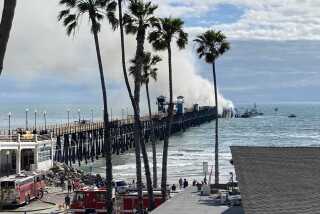Earthquake symposium on risk of collapsing buildings stirs some controversy
It began more than three years ago, when a half-ton piece of stucco fell from the Theme Building at Los Angeles International Airport.
Engineers scrutinized the structure and discovered the arched landmark — the inspiration for the jet-set architecture in “The Jetsons” — was at risk for collapse or irreparable damage in an earthquake.
The discovery came not from a government mandate but because the airport’s owner, Los Angeles World Airports, a city agency, decided to reevaluate the structural fitness of the half-century-old structure in light of the stucco failure.
The revelation resulted in a $10-million effort to voluntarily seismically retrofit the building. To some earthquake experts and structural engineers, the renovation underscores the need for property owners to focus on seismic retrofitting even when it is not mandated by building codes or government laws.
The story of the Theme Building will take center stage Wednesday at a symposium at UCLA called “Imminent Danger,” which will bring in speakers from Caltech, LAX and UCLA to talk about the threat from and economic impact of building collapse in an earthquake.
But the symposium has provoked some controversy among other structural engineers who say the event is being cosponsored by companies — Miyamoto, a structural engineering company with offices on the West Coast and in Tokyo, and Sun Valley-based Tower General Contractors — with a financial interest in drumming up more business for seismic retrofit contracts. (The third cosponsor is UCLA’s George E. Brown Jr. Network for Earthquake Engineering Simulation; all three entities worked on the LAX renovation project.)
“There is an inherent perception of a conflict of interest in its message,” said Fred Turner, a structural engineer with the California Seismic Safety Commission. “Several social science studies suggest that scare tactics do not appear to effectively motivate the public to manage risk. A balanced discussion … is in everyone’s best interest.”
Organizers acknowledged the differences of opinion but said they hoped the symposium would generate more discussion. “There’s clearly some division of opinion, and frankly, that’s part of the reason we’re having this symposium,” said Adam Friedman, spokesman for Tower General Contractors.
Among the speakers is Peter Yanev, a former owner of an Oakland earthquake structural engineering company who now consults on earthquakes for the World Bank.
Yanev said his visits to Chile to review the structures after an 8.8 earthquake struck the country in February led him to question whether California’s current building codes are sufficient for new buildings to handle a massive quake.
Although many Chilean buildings survived the quake without major damage, some of the structures that did collapse or were extensively damaged resembled new office buildings popular in Orange County and the Silicon Valley — “glass, cool-looking boxes,” Yanev said.
Of particular concern, he said, was that the buildings that collapsed or were severely damaged in Chile had more shear walls — massive concrete walls that support the structure — than typical new California buildings.
Yanev’s statements have provoked much consternation among some other structural engineers, who disagree with him.
Jack Moehle, a professor at UC Berkeley’s Pacific Earthquake Engineering Research Center, said all the buildings he inspected in Chile that collapsed lacked a type of reinforcing steel that is wrapped around concrete — a standard that already exists in U.S. building codes.
Moehle also said it’s important to realize that the earthquake in Chile was the fifth largest ever recorded, but that overall, Chilean buildings fared well. He said that out of 102 buildings in the Chilean city of Concepcion that were nine stories or taller, only one collapsed, despite a quake that shook for two or three minutes.
“That’s not to say no buildings will have problems in future earthquakes,” Moehle said, but his observation led him to conclude that U.S. building codes needed no emergency changes. Moehle is writing a report on recommendations on updating building codes for high-rises that will be reviewed by state officials in Sacramento.
Turner said the experience in Chile and a 7.0 quake in New Zealand on Sept. 4 showed that California’s practices are on the right track. Both countries share similar earthquake engineering practices with California.
In New Zealand, “no one was killed,” Turner said. “They did remarkably well. It was very encouraging.”
Still, Turner said, “There are clearly a lot of concerns about older steel-frame buildings, particularly those built prior to the significant changes we sponsored after the Northridge earthquake.... Many of the buildings built prior to that are in fact suspect and should in fact be seismically evaluated.”
The executive directors at the California Building Standards Commission and the California Seismic Safety Commission said they haven’t received all the reports and recommendations learned from Chile, but they haven’t heard anything so far that warrants emergency changes to the building code for new structures.
Caltech engineering seismology professor Thomas Heaton, who will be speaking Wednesday, said it was important for the public to keep in mind that future earthquakes could happen far closer to downtown L.A. than the 1994 Northridge quake and 1971 Sylmar temblor.
“Somewhere, lurking in our future, are even larger-magnitude earthquakes, some that may be close to downtown and move our tall buildings in ways that have never been seen before. And current analysis indicates that they might not do very well in that kind of shaking,” Heaton said.
High-rises, Heaton said, “have done extremely well in earthquakes up to this point.” But tall buildings may not survive future quakes on the scale of the 1906 San Francisco earthquake, which swayed the ground more than five feet and could jeopardize some tall buildings.
The symposium, which runs from 9 a.m. to 3:30 p.m., will be webcast live at https://www.eqsymposium.com.
More to Read
Start your day right
Sign up for Essential California for news, features and recommendations from the L.A. Times and beyond in your inbox six days a week.
You may occasionally receive promotional content from the Los Angeles Times.







